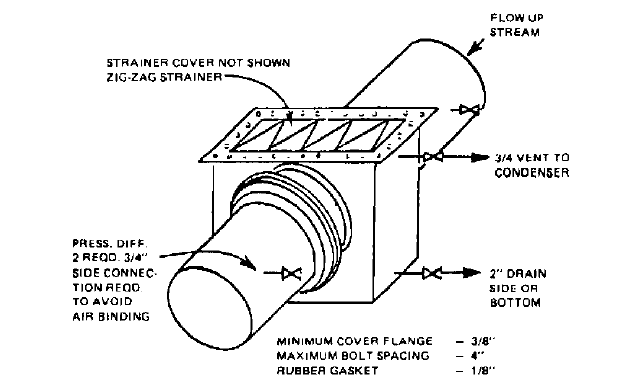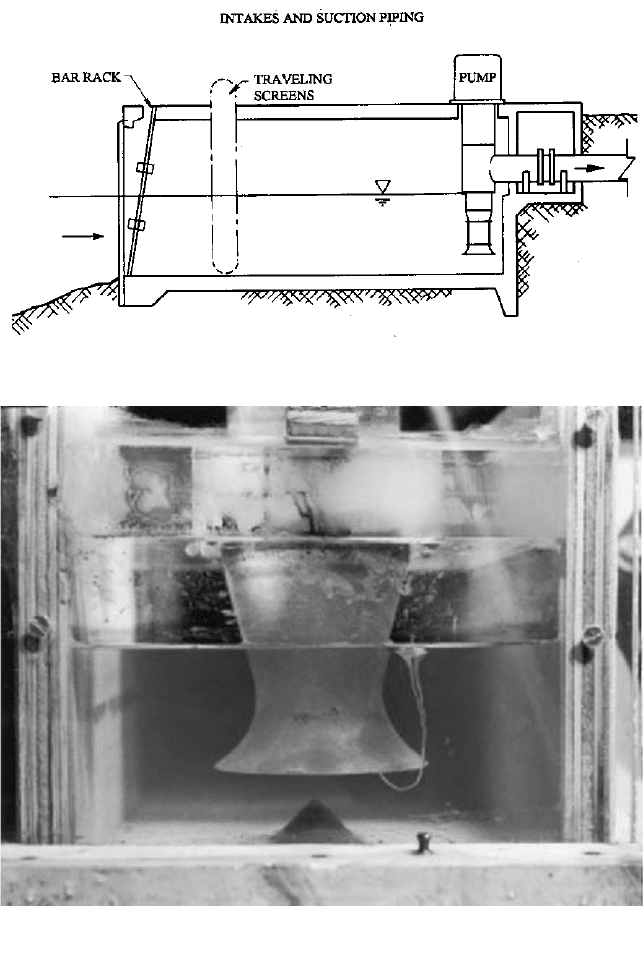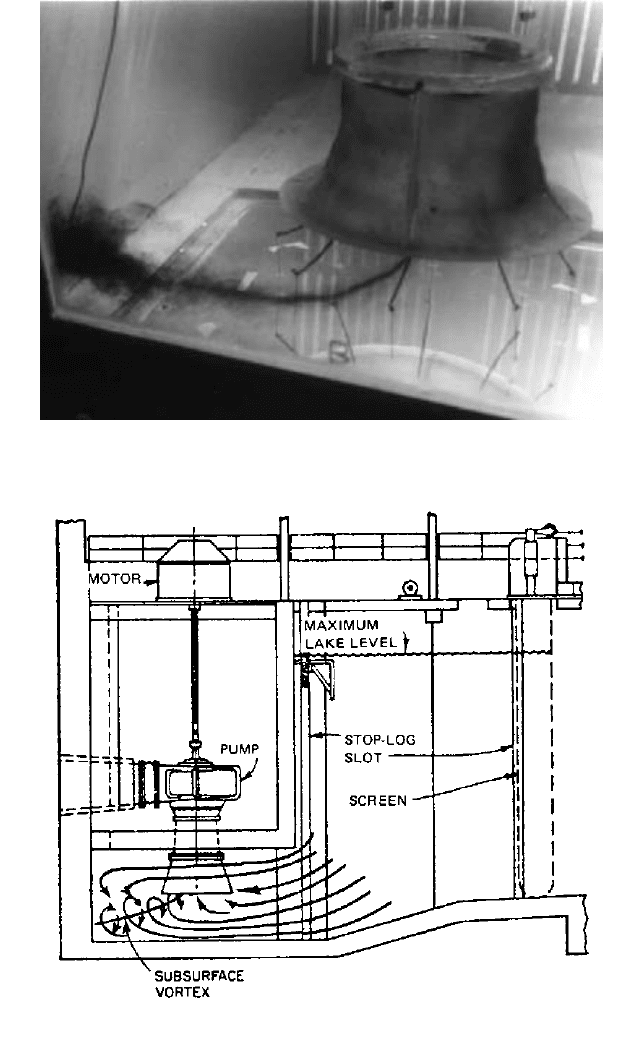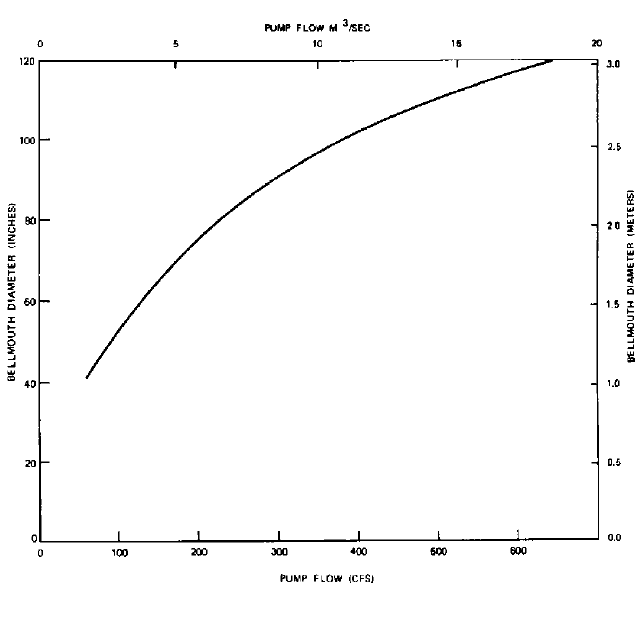Pump Handbook by Igor J. Karassik, Joseph P. Messina, Paul Cooper, Charles C. Heald - 3rd edition
Подождите немного. Документ загружается.


10.36 CHAPTER TEN
FIGURE 28 Box strainer for temporary start-up service. Pressure differential connections are on top or side only.
Upstream mesh is #16 stainless steel with 0.018-in (0.46-mm) wire diameter. Downstream mesh is #2 stainless
steel with 0.063-in (1.6-mm) wire diameter (1 in = 25.4 mm).
REFERENCES
1. American National Standard for Pump Intake Design, ANSI/HI 9.8-1998, Hydraulic
Institute, Parsippany, NJ, www.pumps.org.
FURTHER READING __________________________________________________
Aten, R. E. “Alternative Cooling Water Sources for the ‘Water-Short’ Midwestern States.”
Paper presented at American Power Conference, Chicago, IL, 1979.
Budris, A. R., and Mayleben, P. A. “Effects of Entrained Air, NPSH Margin, and Suction
Piping on Cavitation in Centrifugal Pumps.” 15th International Pump Users Symposium,
Turbomachinery Laboratory, Texas A&M University, College Station, TX, 1998.
Dicmas, J. L. “Development of an Optimum Sump Design for Propeller and Mixed Flow
Pumps.” Paper presented at ASME meeting, New York, 1967.
Dicmas, J. L. “Effect of Intake Structure Modifications on the Hydraulic Performance of a
Mixed Flow Pump.” Joint Symposium on Design and Operation of Fluid Machinery. Vol. 1,
p. 403, June, 1978.
Dornaus, W. L. “Flow Characteristics of a Multiple-Cell Pump Basin.” Trans. ASME, July
1958, p. 1129.
Dornaus, W. L. “Stop Pump Problems Before They Begin with Proper Pit Design.” Power
Engineering Magazine, February 1960, p. 89.
Fraser, W. H. “Hydraulic Problems Encountered in Intake Structures of Vertical Wet Pit
Pumps and Methods Leading to Their Solution.” Trans. ASME, May 1973, p. 3.
Howard, J. H. G., and Hermann, P. “Flow Field Investigation for a Series of Right-Angle
Minimum Axial Depth Pump Intakes.” 2nd International Pump Users Symposium, Tur-
bomachinery Laboratory, Texas A&M University, College Station, TX, 1985.
10.1 INTAKES, SUCTION PIPING, AND STRAINERS 10.37
Langewis, C., Jr., and Gleeson, C.W. “Practical Hydraulics of Positive Displacement Pumps
for High-Pressure Waterflood Installations.” J. Petrol. Technol. 23:173 (1971).
Messina, J. P. “Periodic Noise in Circulating Water Pumps Traced to Underwater Vortices
at Inlet.” Power, September 1971, p. 70.
Mussalli, Y. G., Hofman, P., and Taft, E. P. “Influence of Fish Protection Considerations on
the Design of Cooling Water Intakes.” Paper presented at Joint Symposium on Design and
Operation of Fluid Machinery, Colorado State University, June, 1978.
Prosser, M. J. “The Hydraulic Design of Pump Sumps and Intakes.” BHRA, July, 1977.
Scotton, L. N., and Anson II, D. T. “Protecting Aquatic Life at Plant Intakes.” Power, Janu-
ary 1977, p. 74.
Silvaggio, J. A., Jr. “Air Model Testing to Determine Entrance Flow Fields.” 1st Interna-
tional Pump Users Symposium, Turbomachinery Laboratory, Texas A&M University, Col-
lege Station, TX, 1984.
Tsai, Y. J. “Sediment Control for a Power Plant Intake Screenwell.” Paper presented at
ASME meeting, New York, 1977.
Wallen, P. J., and Towsley, G. S. “A Case History
—
Improvements to an Existing Cooling
Tower Sump and Horizontal Split Case Pumps.” 16th International Pump Users Sympo-
sium, Turbomachinery Laboratory, Texas A&M University, College Station, TX, 1999.

MAHADEVAN PADMANABHAN
JOHANNES LARSEN
10.39
SECTION 10.2
INTAKE MODELING
PROBLEMS ENCOUNTERED IN PUMP INTAKES___________________________
The various hydraulic problems associated with a pump pit include formation of surface
and subsurface vortices, prerotation and swirl, and flow separation at or near the suction
bell of either wet-pit or dry-pit centrifugal pumps (Figures 1a and 2). Any of these prob-
lems can adversely affect pump performance by causing cavitation, vibrations, or loss of
efficiency.
1
Usually there is more than a single reason for these problems, and the extent
of the combined effects is difficult to predict reliably by mathematical modeling or Com-
putational Fluid Dynamics (CFD). Formation of vortices, for example, even though depen-
dent on suction pipe velocity and submergence, is strongly influenced by added
circulation from vorticity sources, such as a nonuniform approach flow resulting from
intake and approach channel geometries; rotational wakes shed from obstructions, such
as columns or piers; and the velocity gradients resulting from boundary layers at the
walls and floor.
2
The circulation contributed by these vorticity sources is unpredictable
and strongly dependent on intake design and operating conditions, especially for large
pumping units with multiple bays fed by a common approach channel. In these cases,
physical modeling is the best way of predicting the behavior of the prototype with a rea-
sonable degree of reliability.
Free Surface Vortices This type of vortex is considered objectionable when it draws air
bubbles or an air core into the pump inlet (Figure 1b). Under nominal approach flow con-
ditions, strong air core vortices causing air ingestion with air concentration as high as 10%
have been reported.
29
It has been established that an air concentration in the suction pipe
of from 3 to 5% can lower pump efficiency.
3
Also, air in the form of large bubbles or slugs
can cause the impeller to vibrate. Strong surface vortices that do not draw air are also
objectionable if they draw debris into the suction pipes and because their high rotational
velocity can reduce the local pressure sufficiently to induce cavitation.

10.40 CHAPTER TEN
FIGURE 1B Free surface vortex can form at pump suction bell entrance due to combination of low submergence,
high suction velocity, nonuniform approach flow, or other vorticity sources (Courtesy of Alden Research Laboratory, Inc.)
FIGURE 1A Typical vertical wet-pit pump intake.
Subsurface Vortices This type of vortex, also known as a submerged vortex (Figures
1c and 2), usually originates from a floor or wall and is induced by vorticity produced in
separation zones close to the pump entrance or, in wet-pit pumps, below the bell. The

10.2 INTAKE MODELING 10.41
FIGURE 2 Typical vertical dry-pit pump intake. Improper spacing of suction bell relative to floor and back wall
caused subsurface vortexing. Model test revealed problem and correction (Reference 4).
FIGURE 1C Subsurface vortex formed at the side wall due to poor flow guidance to the bell; vortex identified in
the model with dye (Courtesy of Alden Resrearch Laboratory, Inc.)
10.42 CHAPTER TEN
reduced pressure in the vortex core causes fluctuating load on the pump impeller along
with associated vibration and noise,
4,5
increased possibility of cavitation, higher inlet
losses, and decreased pump efficiency, especially when the core pressure is sufficiently low
to release dissolved air or other gases from the fluid.
Prerotation and Swirl Swirl is a general term for any flow condition (due to vortexing
or a pipe bend) where there is a tangential velocity component in addition to a usually
predominating axial flow component. Prerotation is a specific term to denote a cross-
sectional average swirl in the suction line of a pump or, in case of a vertical wet-pit pump,
upstream of the impeller.
The prerotation angle is a measure of the strength of the tangential velocity compo-
nent u
t
relative to that of the axial velocity component u in the flow approaching the pump
impeller; that is, tan
1
(u
t
/u). Adverse effects on the pump are decreased capacity and
head when the rotation is in the direction of pump rotation and increased capacity and
head when the rotation is opposite the pump rotation (antirotation). The increased capac-
ity is associated with an increase in power requirement and may cause motor overheating.
Prerotation will influence pump performance because the flow approaching the im-
peller already has a rotational flow field that may oppose or add to the impeller rotation,
depending on direction. The design of the pump blades (that is, shape and angle) usually
assumes no prerotation, and the existence of prerotation implies flow separation along one
side of the impeller blades.The degree of prerotation that should be of concern depends on
the type of pump and may not always be known. Prerotation could be quantified in a
model by an average cross-sectional swirl angle, determined by detailed velocity mea-
surements, or by readings on a swirl meter. Because swirl decays along a pipe as a result
of wall friction, internal fluid shear, and turbulence, the swirl meter in a model suction
pipe should be located near the impeller.
Losses Leading to Insufficient NPSH A poorly designed pump intake could result in
large inlet losses. Losses caused by screens, poor entrance conditions, vortexing and swirl,
and vortex suppression devices may add up to a value so great that the required NPSH
of the pump is not satisfied. Increased inlet losses due to swirl have been reported in lab-
oratory studies.
6
In a nuclear reactor residual-heat-removal sump model, inlet losses in a
preliminary design wherein air core vortices and a high degree of swirl were present were
20% higher than in a revised design with no strong vortices and swirl, and with similar
pipe entrance geometry and flows. Because the degree of vorticity and swirl cannot be pre-
dicted and it is therefore not possible to calculate inlet losses reliably; they are usually
obtained from model studies. With the experimentally derived values of the inlet losses,
the NPSH available should be checked by recalculation.
DESIGN GUIDES _____________________________________________________
As a preliminary design guide (Section 10.1), published information may be used to estab-
lish pump sump dimensions and a minimum desired submergence.
7
—
10
Figures 1 and 2 of
Section 10.1 show the basic layout of a pump sump and present typical dimensions in rela-
tion to the flow required per pump, as published by the Hydraulic Institute.
7
Some of these
references may express sump dimensions in terms of bell mouth diameter, and Figure 3
shows the typical relationship between design flow for a given wet-pit pump and the bell
mouth diameter required to achieve reasonable and desirable velocities approaching the
impeller. One should be aware that the sump dimensions and minimum derived submer-
gences given by design guides are considered applicable for the ideal condition of a simple,
straight approach flow with a constant, low approach velocity to the pump sump.
The need for a physical model study still exists when site or operating conditions make
the ideal condition impossible. For example, for a particular pump intake configuration, a
hydraulic model study indicated that a strong submerged floor vortex existed with floor
clearance of 0.5 times the bell diameter (a usual design value) and that a reduced floor

10.2 INTAKE MODELING 10.43
FIGURE 3 An approximate relationship between design flow and required suction bell diameters for vertical
propeller pumps for preliminary evaluations.
clearance of 0.3 times the bell diameter eliminated the vortex. Typically, for pump intakes
of the following types, model studies should be considered essential:
1. Intakes with nonsymmetric approach flow; for example, an offset in the approach
channel
2. Intakes with multiple pump bays with a common approach channel and a variety of
pump operating combinations
3. Intakes with pumps of capacities greater than 40,000 gpm (2.5 m
3
/s) per pump
4. Intakes with expanding approach channel
5. Intakes with possibilities of screen blockages or obstructions close to suction pipe
entrance; for example, reactor containment recirculation sumps, gate guides for dry-
pit pumps
6. Dual flow screens intake
For items 1, 2, 4, 5, and 6, a model study is recommended because of the unknown
effects a nonuniform approach flow can have on vortexing and swirl. For item 3, consider-
ing the cost of large pump installations and the cost of backfit, should problems occur, a
model study is recommended to ensure proper pump operation.

10.44 CHAPTER TEN
MODEL SIMILITUDE __________________________________________________
The principle of dynamically similar fluid motion forms the basis for the design and oper-
ation of hydraulic models and the interpretation of experimental data. The basic concept
of dynamic similarity is that two systems with geometrically similar boundaries have sim-
ilar flow patterns at corresponding instants of time.
11,12
To achieve this, all individual
forces acting on corresponding fluid elements must have the same ratios in the two geo-
metrically similar systems. The condition required for complete similitude may be devel-
oped from Newton’s second law of motion:
(1)
where F
i
inertial force, defined as mass m times acceleration a
F
p
pressure force connected with or resulting from the motion
F
g
gravitational force
F
v
viscous force
F
t
surface tension force
Additional forces, such as fluid compression, magnetic, or Coriolis forces, may be rele-
vant under special circumstances, but generally these forces have little influence and are,
therefore, not considered in the following development.
Equation 1 can be made dimensionless by dividing all the terms by F
i
. Two systems of
different size that are geometrically similar are dynamically similar if both satisfy the
same dimensionless form of Equation 1. We may write each of the forces of Equation 1 as
F
p
net pressure difference area a
1
pL
2
F
g
specific weight volume a
2
gL
3
F
v
shear stress area (a
3
mu/y) (area) a
3
muL
F
t
surface tension length a
4
sL
F
i
density volume acceleration a
5
rL
3
u
2
/L a
5
ru
2
L
2
where
a
1
, a
2
, and so on proportionality factors
p net pressure difference
L representative linear dimension
g specific weight rg
m dynamic viscosity
u/Dy depth-wise velocity gradient
u representative velocity
s surface tension
r density
g acceleration due to gravity
Noting that the kinematic viscosity, n, is given by m/r, substituting the above terms in
Equation 1 and making it dimensionless by dividing by the inertial force, we obtain
(2)
where
E
u
2¢p>r
Euler number
inertial force
pressure force
a
1
a
5
E
2
a
2
a
5
F
2
a
3
a
5
R
1
a
4
a
5
W
1
1
F
i
F
p
F
g
F
v
F
t

10.2 INTAKE MODELING 10.45
Because the proportionality factors a
1
, a
2
, and so on, are the same in model and proto-
type, complete dynamic similarity is achieved if the values of each dimensionless group, E,
F, R, and W are equal in model and prototype. In practice, this is difficult to achieve. For
example, to have F
model
F
prototype
and R
model
R
prototype
requires either a 1:1 “model” or a
fluid of very low kinematic viscosity in the reduced-scale model. Hence, the accepted
approach is to select the predominant force and then design the model according to the
appropriate dimensionless group.The influences of the other forces become secondary and
are called scale effects.
11,12
Froude Scaling Pump intake models are generally designed and operated using Froude
similarity because the flow is controlled by gravitational and inertial forces. The Froude
number is, therefore, made equal in model and prototype:
(3)
where m, p, and r denote model, prototype, and ratio between model and prototype.
In modeling a pump intake sump to study the formation of vortices, it is important to
select a reasonably large geometric scale to achieve large Reynolds numbers. At a large
Reynolds number, energy loss coefficients usually behave asymptotically with Reynolds
number. Hence, with F
r
1 and a sufficiently high Reynolds number, the Euler number E
will be equal in model and prototype. This implies that flow patterns and loss coefficients
may be considered similar in model and prototype. From Equation 3, the velocity, flow, and
time scales are
(4)
(5)
(6)
For example, if a model-to-prototype scale of 1:10 is used, a prototype velocity of 1.0 ft/s
(0.3 m/s) becomes a model velocity of (1 10)
1/2
0.32 ft/s (0.09 m/s). In the model, all
physical dimensions of the pump bays and approach channel are scaled to the ratio 1:10.
Submergence, being a linear dimension, is also scaled to 1:10. A flow of 100 gpm
(0.006 m
3
/s) in the model corresponds to a flow of 100 10
2.5
31,623 gpm (2 m
3
/s) in the
prototype. Similitude parameters and laws are treated in detail in References 11 and 12.
Similarity of Vortices The fluid motions involving vortex formation in pump sumps
have been studied by several investigators. It can be shown by principles of dimensional
analysis that the dynamic similarity of fluid motion that could cause vortices at an intake
is governed by the following dimensionless parameters:
where u average axial velocity at the bell entrance
circulation contributing to vortexing
d diameter of the bell entrance
s submergence at the bell entrance
ud
,
u
2gd
,
d
s
,
ud
n
, and
u
2
d
s>r
t
r
L
r
0.5
Q
r
L
r
2
u
r
L
r
2.5
u
r
L
r
0.5
F
r
F
m
>F
p
1
W
u
2
L
s>r
Weber number
inertial force
surface tension force
R
uL
2m>r
Reynolds number
inertial force
viscous force
F
u
2gL
Froude number
inertial force
gravitational force

10.46 CHAPTER TEN
n kinematic viscosity of water
g acceleration due to gravity
s surface tension of water air interface
r water density
The influence of viscous effects is defined by the parameter ud/n R, the Reynolds
number. Surface tension effects are indicated by u
2
dr/s W, the Weber number. As strong
air-core type vortices, if present in the model, would have to be eliminated by a modified
sump design, the main concern for interpretation of model performance involves the sim-
ilarity of weaker vortices. If the influence of viscous forces and surface tension on vortex-
ing is negligible, dynamic similarity is obtained by equating the parameters ud/,u/
and d/s in model and prototype. A Froude model satisfies this condition, provided the
approach flow pattern in the vicinity of the sump, which governs the circulation, , is prop-
erly simulated.
Considerable research on scaling free surface and submerged vortices has been con-
ducted in the past few years. From a study of horizontal outlets for a depressed sump, it
was determined that for pipe Reynolds numbers above 7 10
4
, no scale effect on vortex
strength, frequency, or air withdrawal existed.
30
Another study indicated that an inlet
Reynolds number of 3 10
4
is sufficient to obtain a good model to prototype correlation of
vortices.
6
Surface tension effects on vortexing have been shown to be negligible for Weber
numbers greater than 120 based on laboratory experiments.
14
A review of all available data on model versus prototype vortex intensity indicated neg-
ligible scale effects for weak vortices and small scale effects for air drawing vortices, and
that this effect could be overcome by a relatively small increase in model flow rate.
27
The
model flow rate should only be increased by an amount such that sufficient Reynolds and
Weber numbers result. Excessively increasing the model flow, particularly to prototype
velocity, produces highly exaggerated vortices incompatible with prototype observations.
DESIGN AND OPERATION OF MODELS__________________________________
Model Scale
Scale effects are less as model size increases but construction and opera-
tion costs increase with model size, so a compromise must be made. In general, the for-
mation of vortices, both free surface and submerged, is highly responsive to approach flow
patterns, and it is important to select a geometric scale that achieves Reynolds numbers
large enough to keep the flow turbulent and to meet the fluid mechanic criteria for min-
imizing scale effects.
13
Also, one should consider other factors such as access for instru-
ments, accurate flow measurements, and ease of modification in selecting a proper scale.
Information on preferred minimum values of Reynolds number and Weber number,
discussed earlier, may be used in designing a model and deciding geometric scale. How-
ever, adhering to these limits does not, in itself, guarantee negligible scale effects in a
Froude model because these limits are based on tests run under ideal laboratory condi-
tions. In real situations, there is usually more than one source of vorticity generation of
unknown extent, and a generalization of scale effects for all cases would be inappropriate.
To compensate for such unknown scale effects, a common practice is to test a model at
higher-than-Froude scaled flows.
A special test procedure involving high temperatures may be used to determine any
scale effects and to project the model results to prototype ranges of Reynolds numbers.
2
The water temperature in the model is varied over a range, say 50 to 120°F (10 to 49°C),
and flow velocities in the pipes are varied over a range of values, if possible, up to the pro-
totype velocities.Vortexing and other flow patterns over a range of Reynolds numbers are
obtained from these tests and can be used to evaluate any possible scale effects. A predic-
tion of the prototype performance can be made based on these tests.
Extent of Model It is very important to include a sufficient length of approach channel
in the model because approach flow nonuniformities contribute greatly to vortex forma-
tion and swirl. The decision on what approach length should be included is usually based
2gd,
